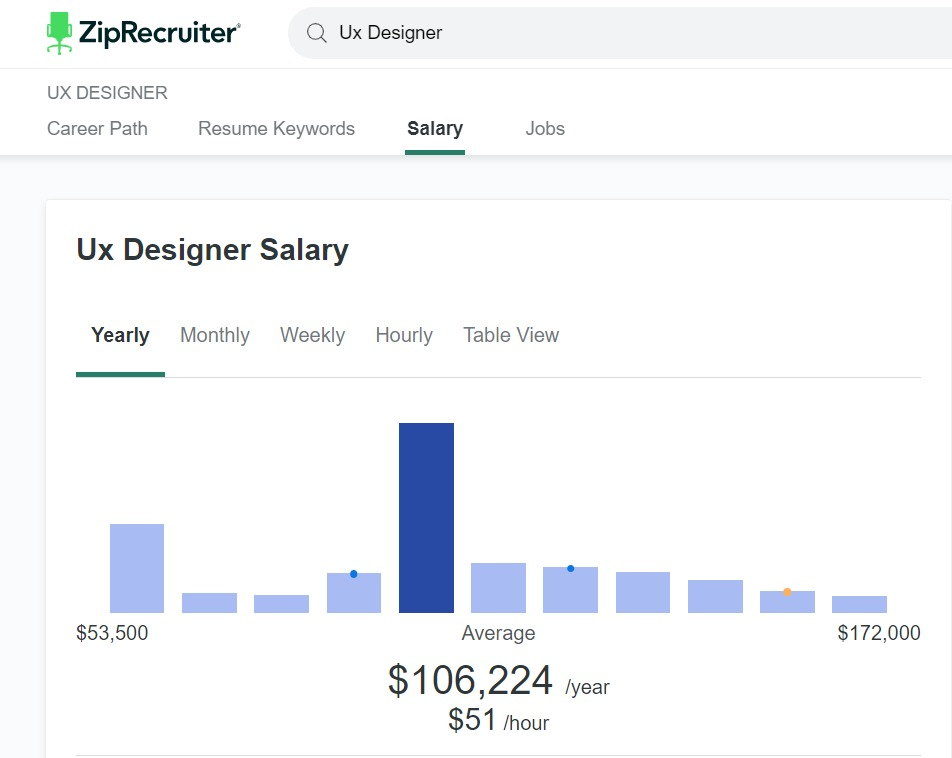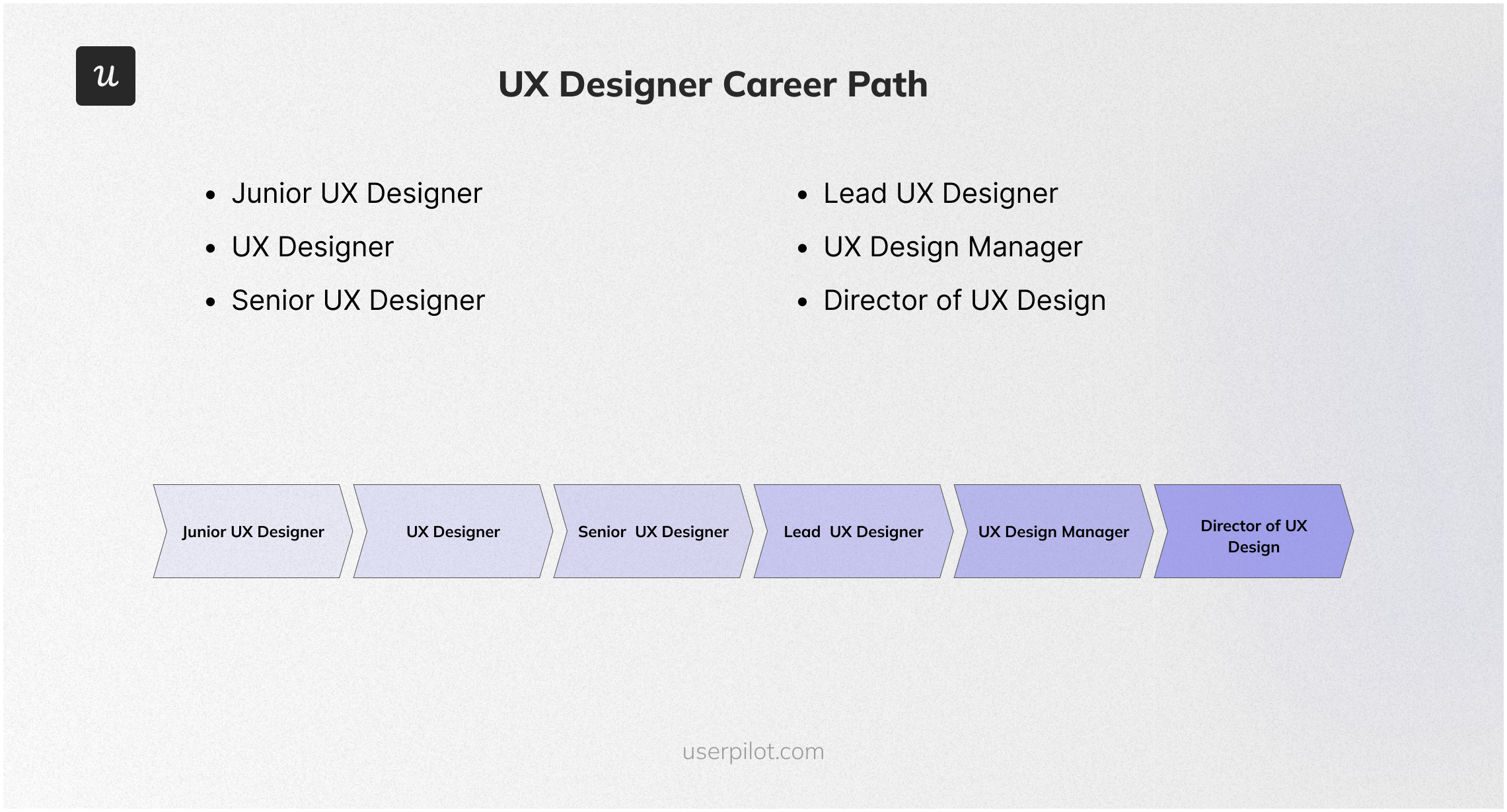![UX Designer Salary [+ Resources to Advance]](https://blog-static.userpilot.com/blog/wp-content/uploads/2024/07/UX-Designer-Salary-Resources-to-Advance.png)
Try Userpilot Now
See Why 1,000+ Teams Choose Userpilot

How much does a UX designer make?
A career as a UX designer can be financially rewarding, with salaries varying based on experience, location, and industry. Here’s a detailed breakdown:
Salary by Experience
- Entry-Level (0-2 years): $60,000 – $77,007 per year.
- Mid-Level (2-5 years): $74,000 – $122,000 per year.
- Senior UX Designer (5-10 years): $125,000 – $194,000 per year.
- Principal or Staff UX Designer (5-8 years): $175,000 – $261,000 per year.
- Director of UX Design (8+ years): $184,000 – $290,000 per year.
Salary by Location
- San Francisco, CA: $101,453 per year.
- New York, NY: $101,279 per year.
- Los Angeles, CA: $99,489 per year.
- Denver, CO: $93,253 per year.
- Seattle, WA: $92,376 per year.
- Houston, TX: $83,117 per year.
- Columbus, OH: $83,289 per year.
Salary by Industry
- Technology: Generally ranges from $92,000 to $146,000 per year.
- Finance: Typically between $86,000 and $134,000 annually.
- Healthcare: Often falls between $75,000 and $120,000 per year.
- Retail: Usually ranges from $70,000 to $110,000 annually.
Highest Paying Companies
- Google: $139,000 – $194,000 per year.
- LinkedIn: $115,000 – $220,000 per year.
- Meta (Facebook): $110,000 – $210,000 per year.
- Apple: $105,000 – $200,000 per year.
These figures highlight the lucrative nature of a career in UX design, especially within top tech companies and in major metropolitan areas.

UX designer career path
A career in UX design involves progressing through various roles, each with increasing responsibility and expertise.
Here’s a typical career progression for a UX Designer:
- Junior UX Designer: Focuses on learning design tools, assisting senior designers, and supporting user research efforts. To progress, build a strong portfolio, seek feedback, and gain practical experience through internships or entry-level positions.
- UX Designer: Conducts user research, creates wireframes and prototypes, and collaborates with cross-functional teams. To advance, take on more complex projects, refine your skills, and develop a deeper understanding of UX principles and methodologies.
- Senior UX Designer: Leads major design projects, mentors junior designers, and plays a key role in strategic planning. To progress, enhance leadership skills, contribute to creating design systems, and build strong relationships with product managers and developers.
- Lead UX Designer: Oversees the design team, ensures design consistency, and aligns design goals with business objectives. Develop project management skills, drive innovation within the team, and engage in high-level strategic planning.
- UX Design Manager: Manages the UX design team, coordinates design efforts across projects, and ensures alignment with overall business strategy. Enhance managerial skills, stay updated with industry trends, and focus on optimizing team performance and design processes.
- Director of UX Design: Sets the overall design strategy for the organization, collaborates with top executives, and ensures the design vision aligns with the company’s mission. Focus on strategic leadership, expand influence across departments, and drive the company’s design innovation.
Each step in this career path builds on the previous one, emphasizing continuous learning, leadership, and strategic thinking to progress to higher levels of responsibility and influence in the field of UX design.
Best practices to be a great UX designer
To excel as a UX designer, it’s essential to adopt practices that enhance creativity, collaboration, and user-centric design.
- Empathize with Users: Deeply understand users’ needs, pain points, and behaviors through thorough research. This helps create genuinely user-centric designs and solve real problems.
- Communicate Effectively: Articulate design ideas and research findings to team members and stakeholders. Good communication ensures alignment and facilitates collaboration.
- Iterate Based on Feedback: Embrace an iterative design process, using user feedback and testing results to refine and improve designs continuously.
- Stay Updated with Trends: Keep up with the latest design trends, tools, and technologies. Continuous learning brings fresh ideas and innovations to your projects.
- Focus on Usability: Prioritize creating intuitive and accessible designs. Conduct usability testing to identify issues and ensure the product is user-friendly and meets user expectations.
Best resources for UX designers
To excel in UX design, it’s important to continually learn and stay updated with the latest trends and best practices. Here are some top resources for UX designers, including books, webinars, podcasts, and blogs.
Best books for UX designers
Reading books by industry experts can provide deep insights and practical knowledge about UX design.
- “The Design of Everyday Things” by Don Norman – A classic book that explores the principles of good design and user experience.
- “Don’t Make Me Think” by Steve Krug – Focuses on web usability and intuitive design principles.
- “Lean UX” by Jeff Gothelf and Josh Seiden – Integrates UX with Agile methodologies for more collaborative and effective design processes.
- “Hooked: How to Build Habit-Forming Products” by Nir Eyal – Discusses the psychology behind user habits and how to create engaging products.
- “Inspired: How to Create Products Customers Love” by Marty Cagan – A guide on product management and creating products that resonate with users.
Best webinars for UX designers
Webinars offer real-time learning and insights from industry experts.
- Userpilot Webinars – Focus on user onboarding, engagement, and product growth.
- NNG (Nielsen Norman Group) Webinars – Expert insights on various UX topics, including usability and user research.
- Interaction Design Foundation Webinars – Cover a wide range of UX research and design principles.
- Baymard Institute Webinars – In-depth discussions on e-commerce usability and UX research.
- UX Design Institute Webinars – Detailed webinars on UX design principles and career development.
Best blogs for UX designers
Following blogs can help you stay updated on the latest trends, tips, and best practices in UX design.
- Userpilot Blog – Insights on user onboarding, product growth, and UX design.
- NNG (Nielsen Norman Group) Blog – Research-based articles on UX design and usability.
- Smashing Magazine – Covers a wide range of topics, including UX design, web development, and product management.
- UX Matters – Offers practical advice and insights on various UX research and design topics.
- UX Collective – Community-driven platform with articles on UX research, design, and industry trends.
These resources provide valuable knowledge and practical advice, helping you stay current and excel in your role as a UX Designer.
Best podcasts for UX designers
Listening to podcasts is a convenient way to stay informed and inspired by industry leaders while on the go.
- “User Defenders” – Interviews with UX design heroes sharing their stories and insights.
- “The UX Intern” – Conversations with UX professionals about their career paths and experiences.
- “UI Breakfast” – Discussions about UI/UX design, product strategy, and business with various experts.
- “What is Wrong with UX” – Experienced UX designers critique current trends and practices.
- “Awkward Silences” – Focuses on user research and customer experience insights.
Best tools for UX designers
Having the right tools is crucial for UX designers to enhance productivity, creativity, and collaboration.
Here are some of the best tools tailored for specific use cases:
- Best tool for User Onboarding and Engagement – Userpilot: Userpilot helps UX designers create personalized in-app experiences and smooth onboarding processes. It allows for real-time user feedback and insights to improve user engagement and retention.
- Best tool for Project Management – Monday: Monday.com offers a visual and flexible platform for managing projects and tasks. It’s ideal for UX designers to track project progress, collaborate with team members, and meet deadlines.
- Best tool for Product Management – Jira Software: Jira Software is perfect for tracking and managing design tasks, user stories, and sprints. It ensures seamless communication between designers and developers, facilitating efficient project workflows.
- Best tool for Customer Experience – Zendesk: Zendesk provides comprehensive customer support solutions. UX designers can use it to gather and analyze user feedback and support tickets, identifying areas for improvement in the user experience.
- Best tool for UX/UI Design – Figma: Figma supports real-time collaboration on design projects, making it ideal for creating wireframes, prototypes, and high-fidelity designs. It allows for easy sharing and feedback collection.
- Best tool for Documentation and Collaboration – Confluence: Confluence allows UX designers to create, share, and manage design documentation. It’s perfect for maintaining a centralized repository of design guidelines, research findings, and project documentation.
- Best tool for Customer Success – ClientSuccess: ClientSuccess helps monitor and analyze customer success metrics. UX designers can use it to understand user outcomes and iterate on designs to improve overall customer satisfaction.
- Best tool for Data Analytics – Tableau: Tableau offers powerful data visualization capabilities, allowing UX designers to analyze and present user research data in an intuitive and visually appealing way.
These tools collectively empower UX designers to conduct thorough research, manage projects effectively, collaborate with teams, and present data-driven insights that enhance user experience design.
Conclusion
Now that you have a better understanding of the salary range for a UX designer position, you can take steps to improve your earning potential.
Consider pursuing relevant certifications, developing your skillset, or negotiating effectively during the job offer stage.
Looking into tools for UX designers? Userpilot is an all-in-one product platform with engagement features and powerful analytics capabilities. Book a demo to see it in action!









